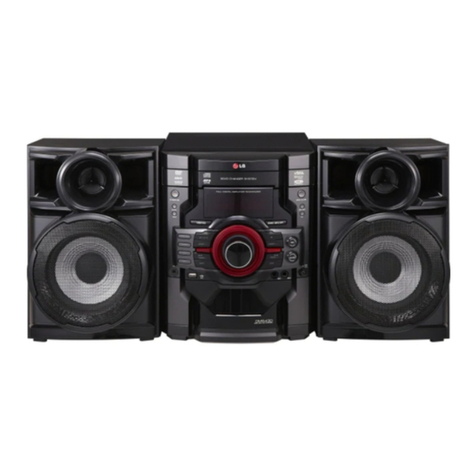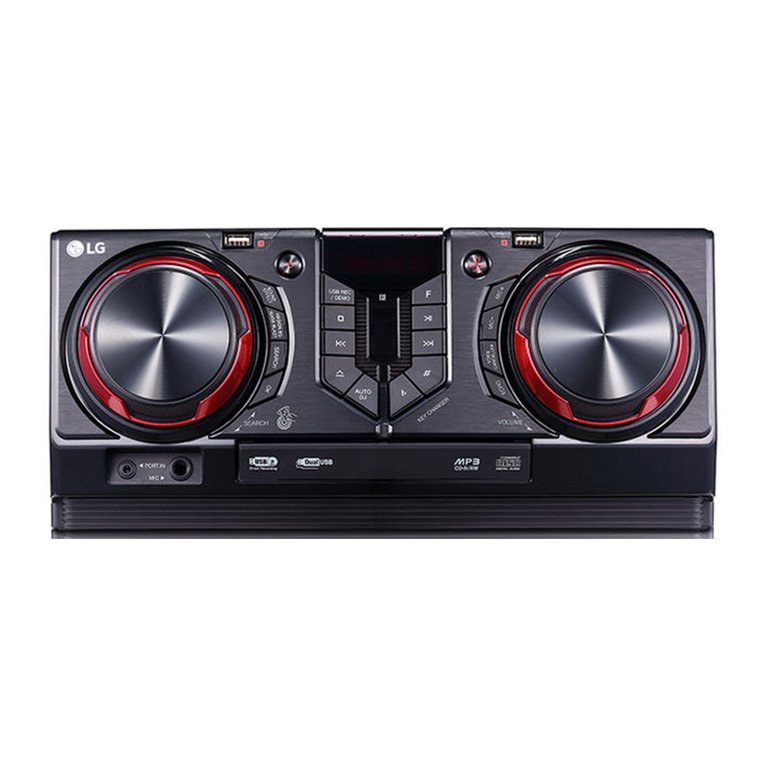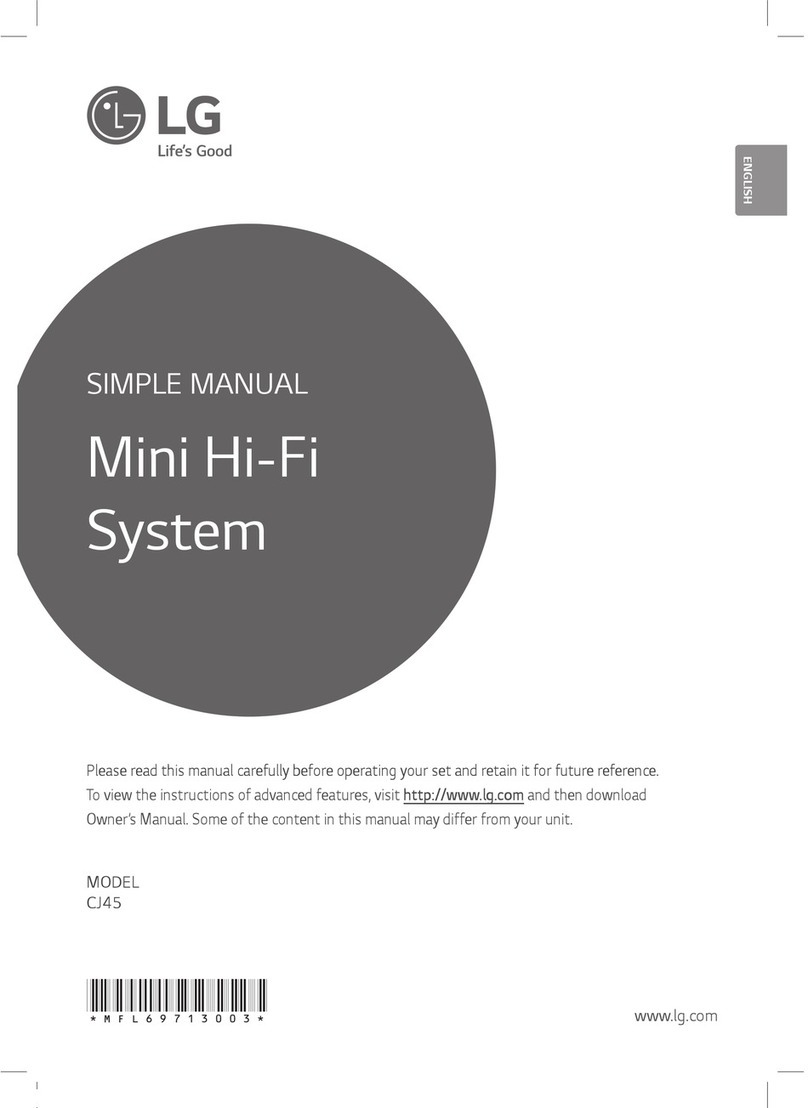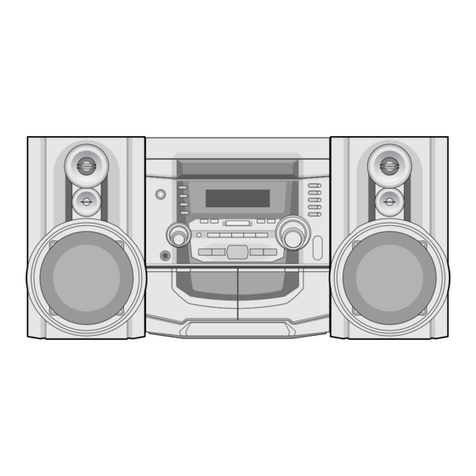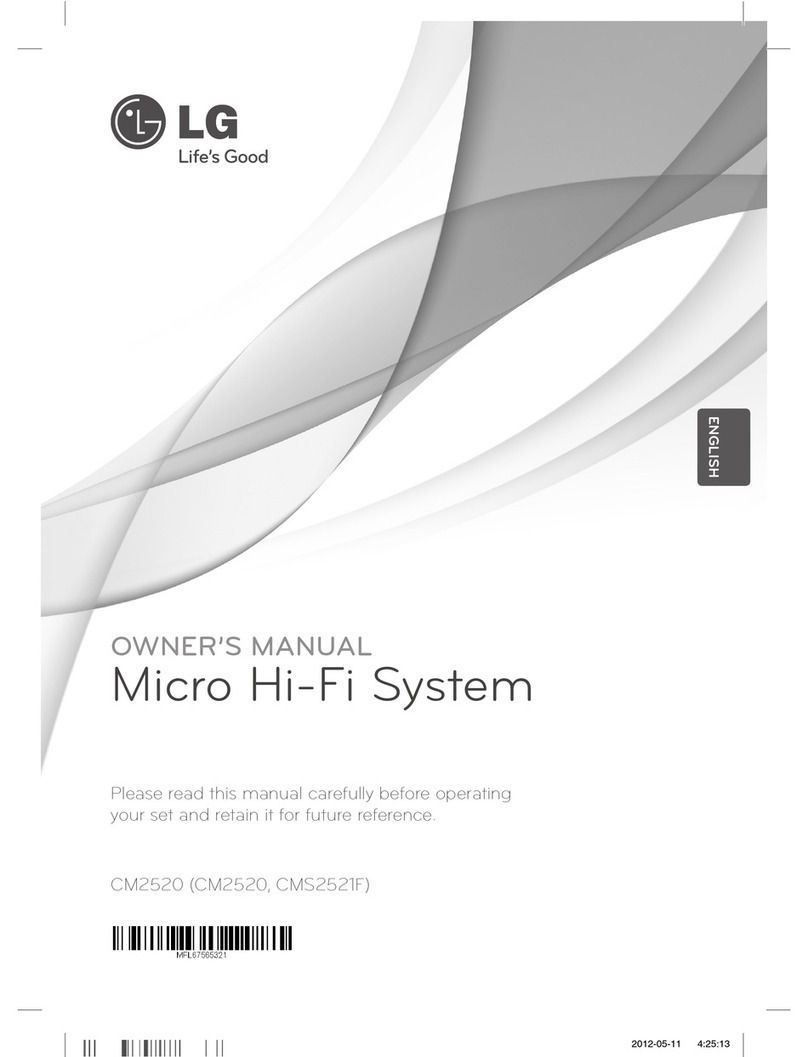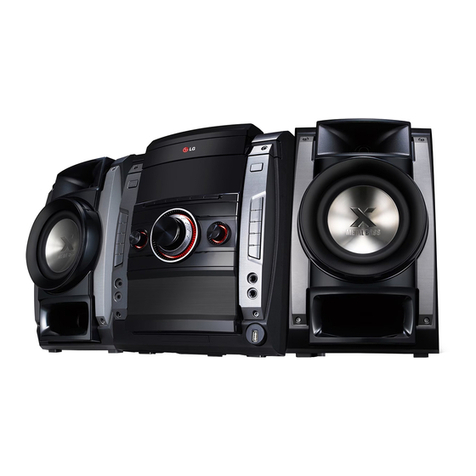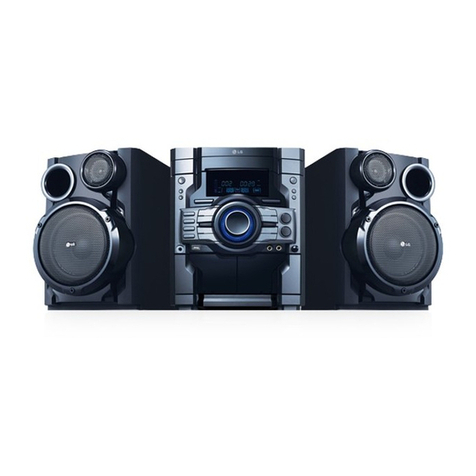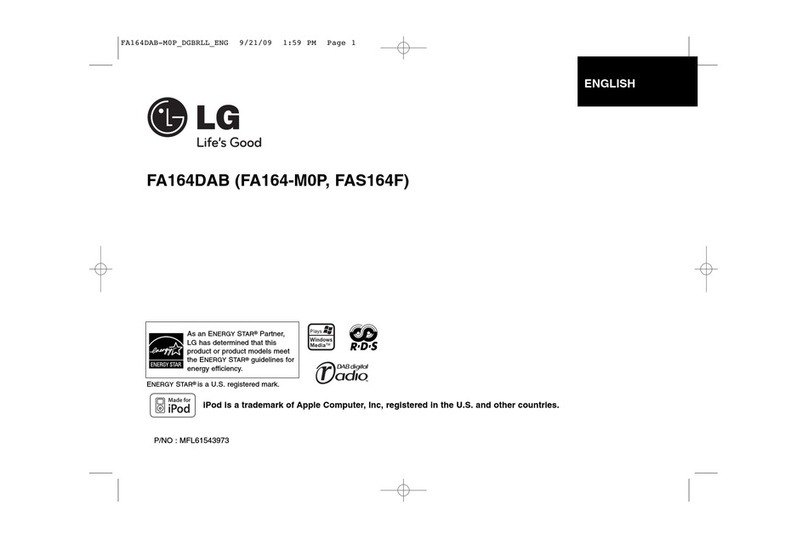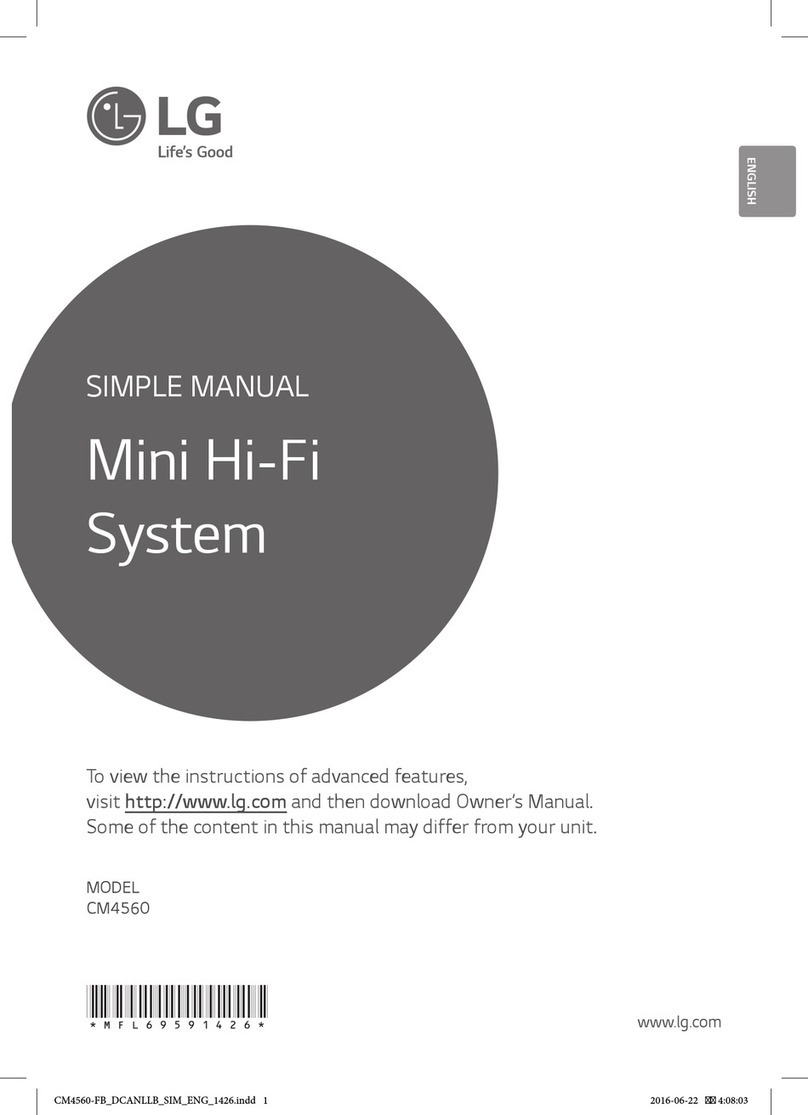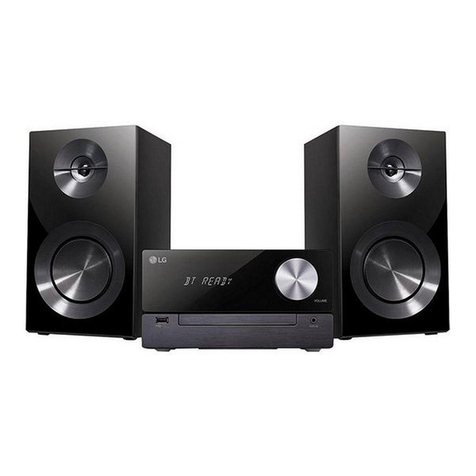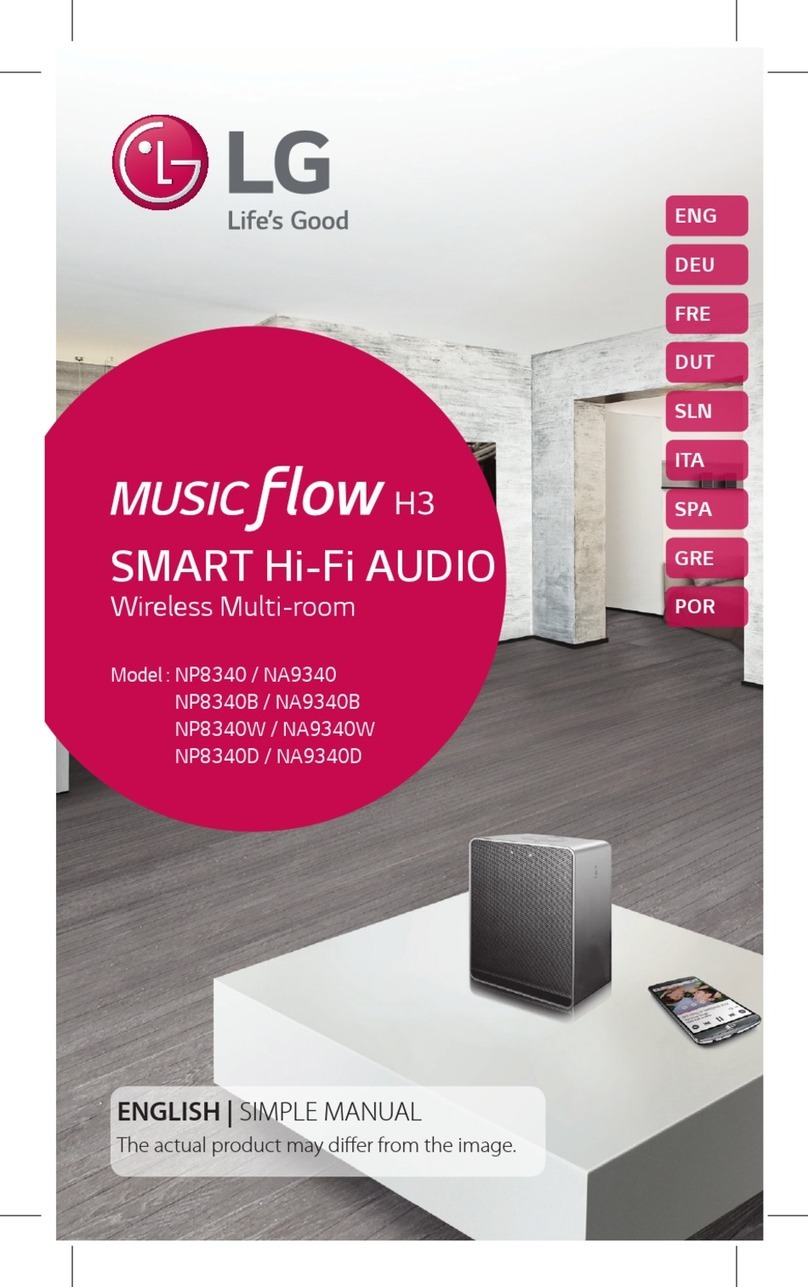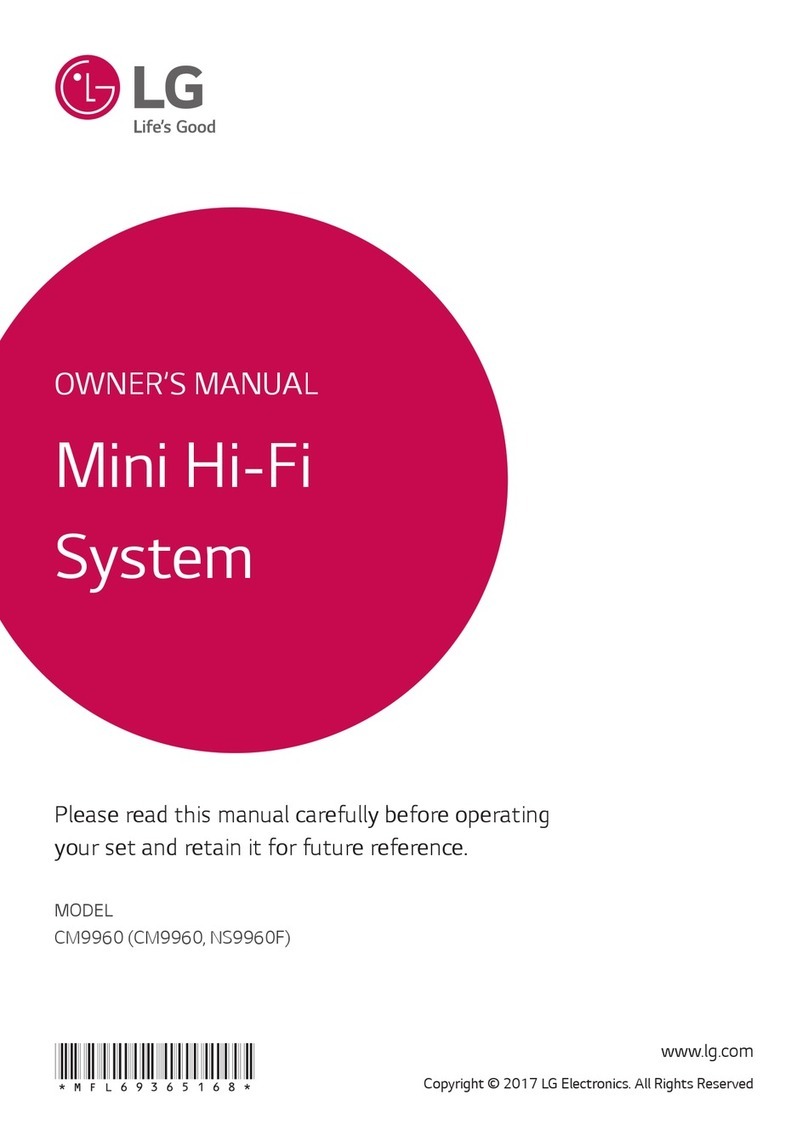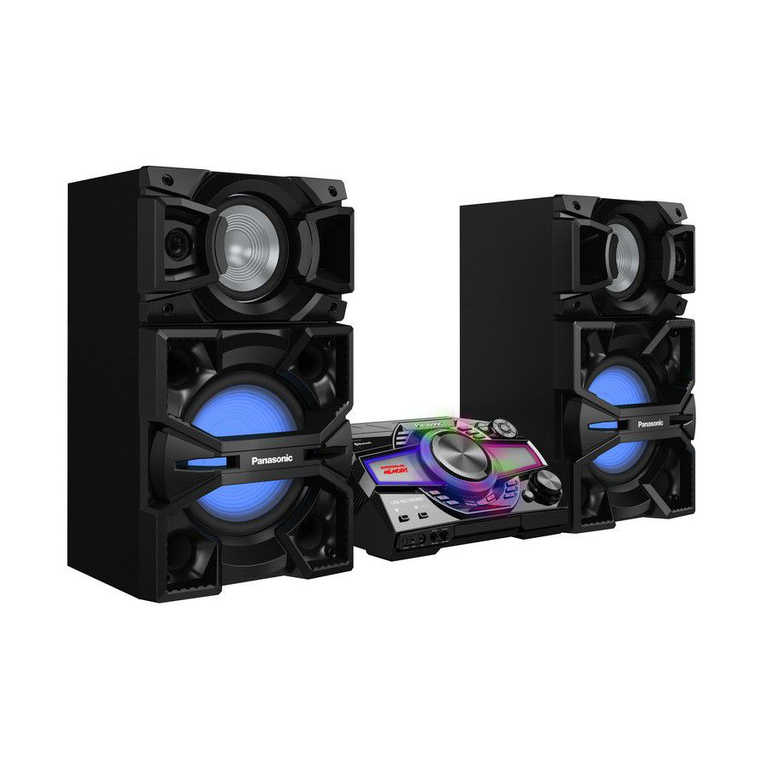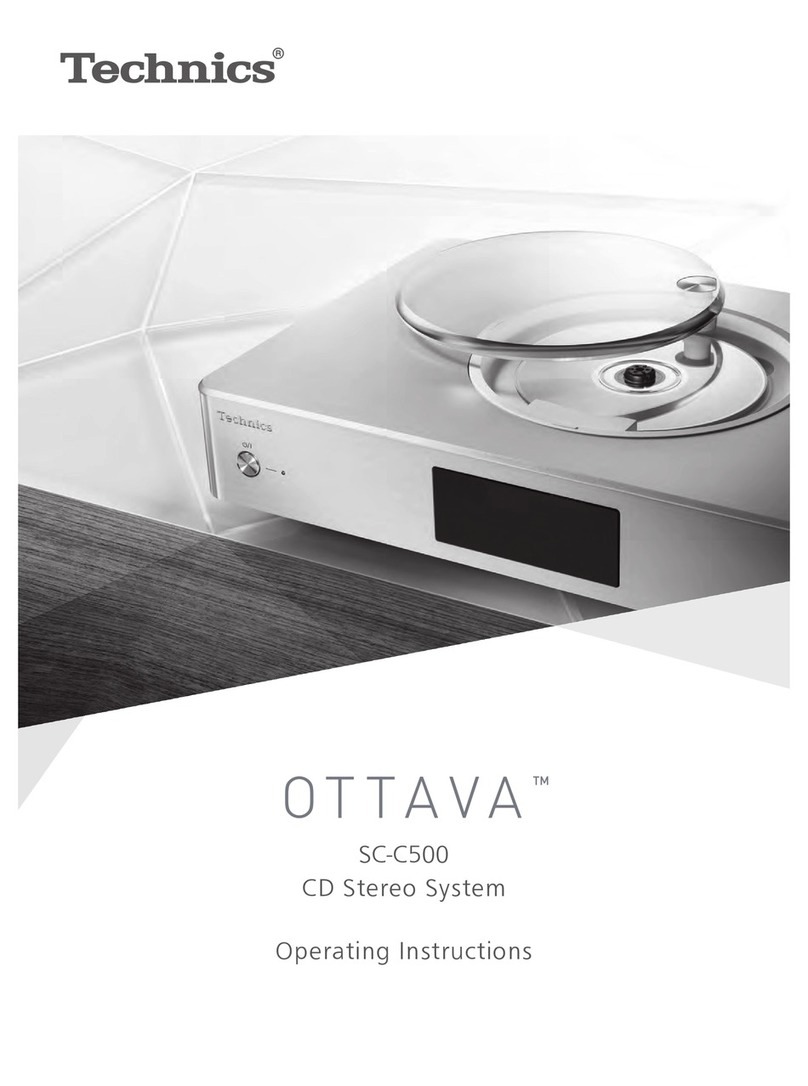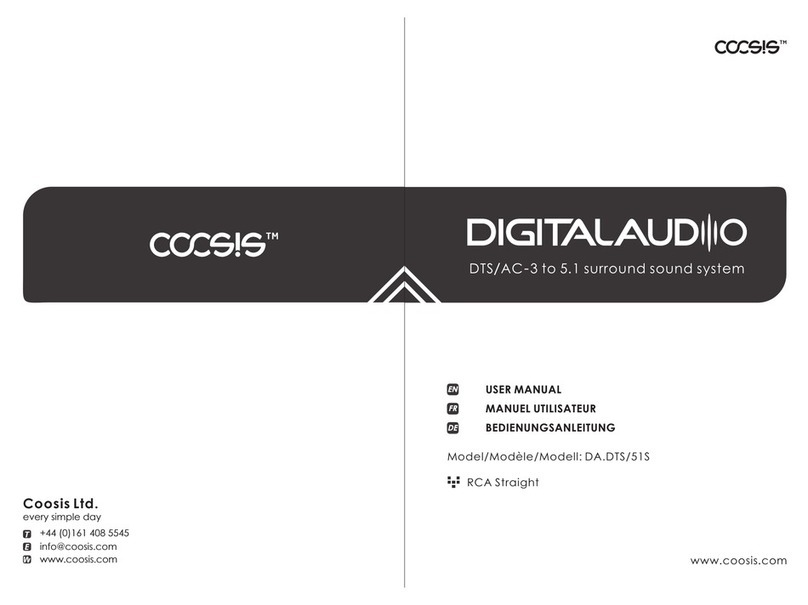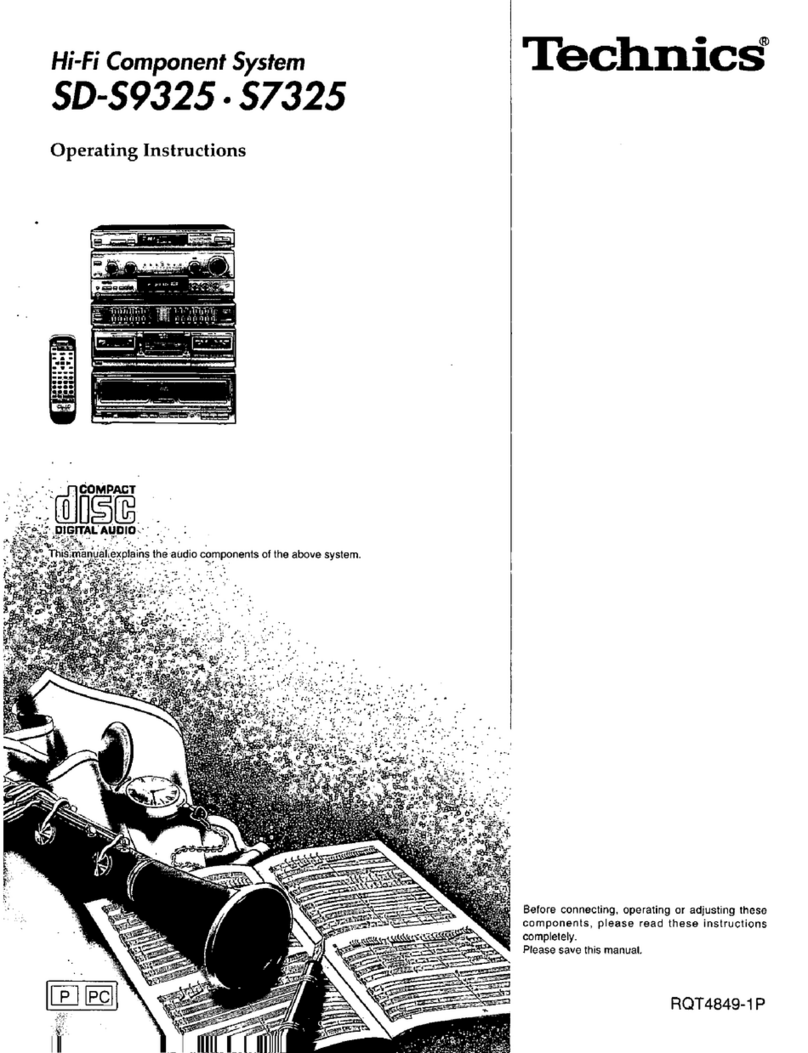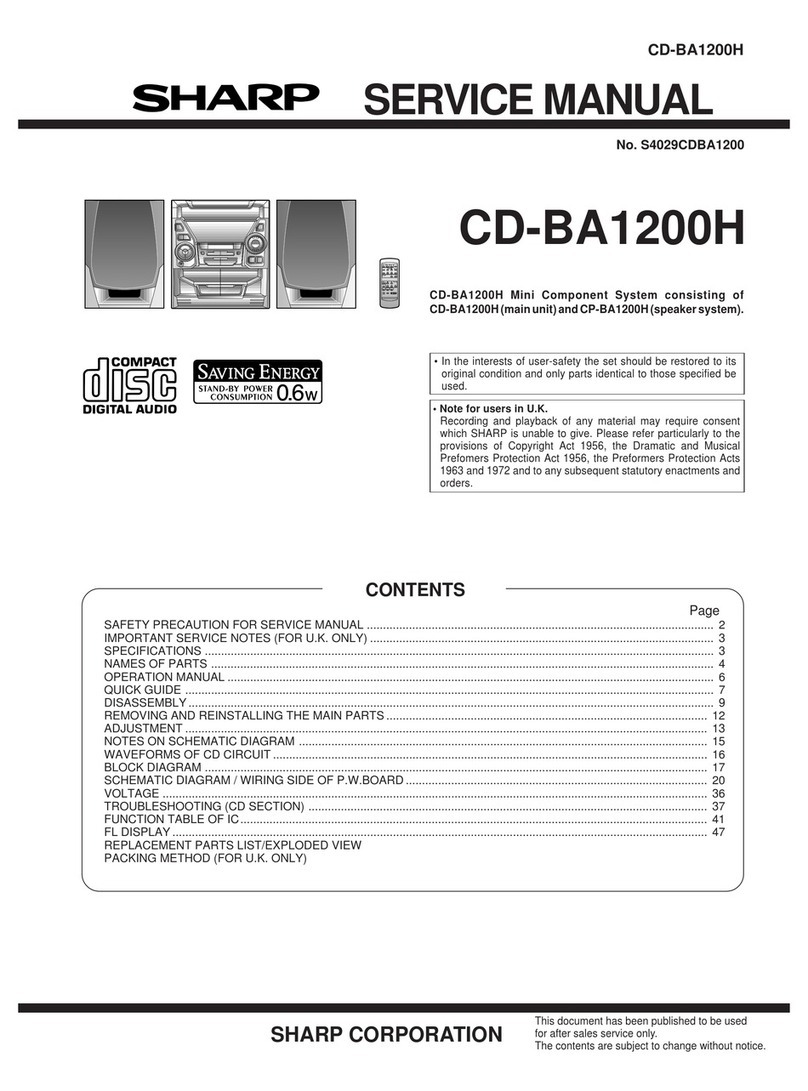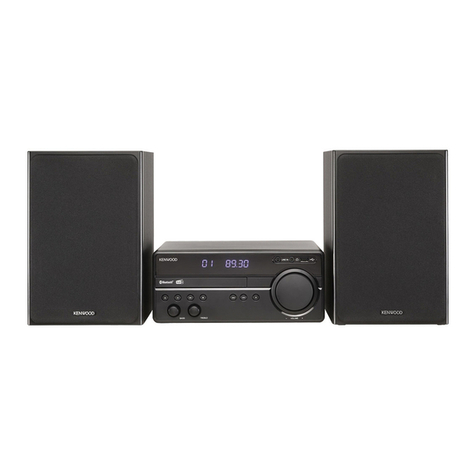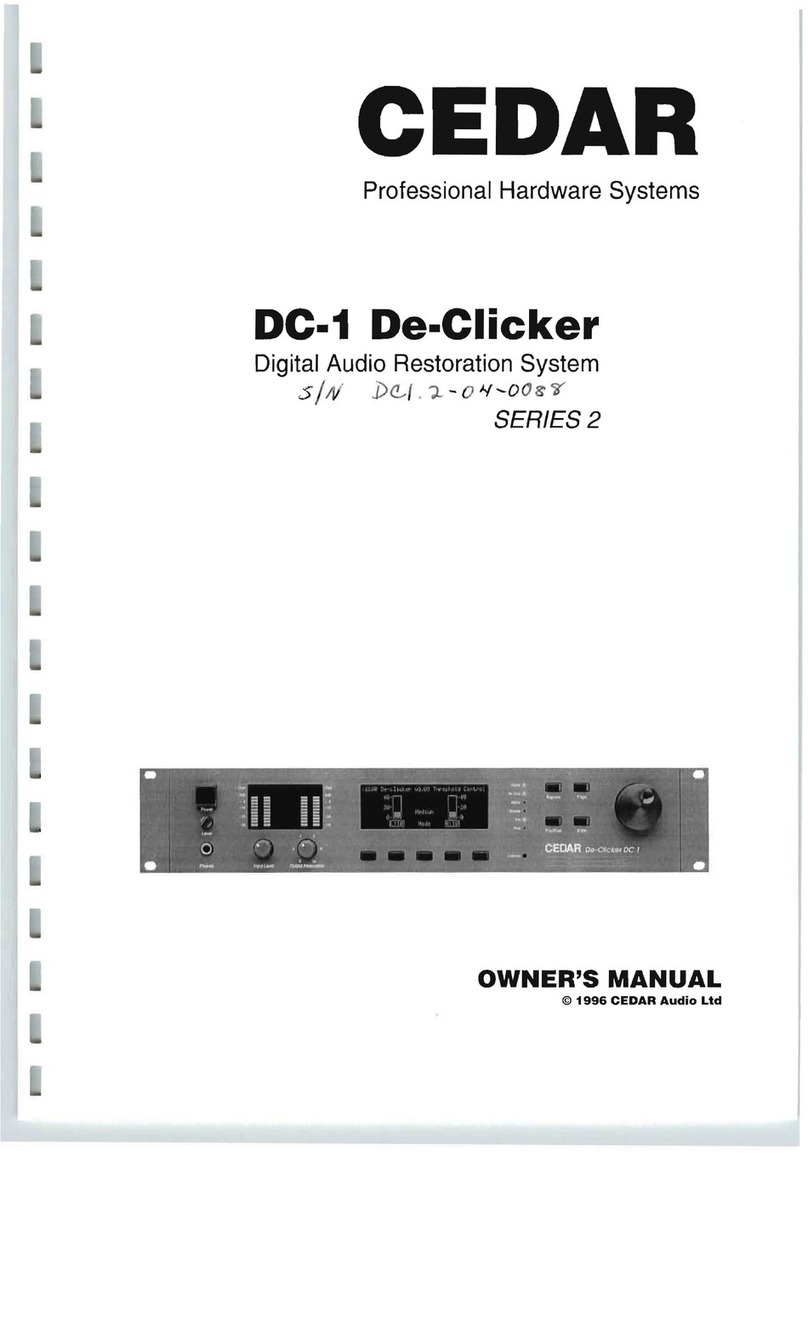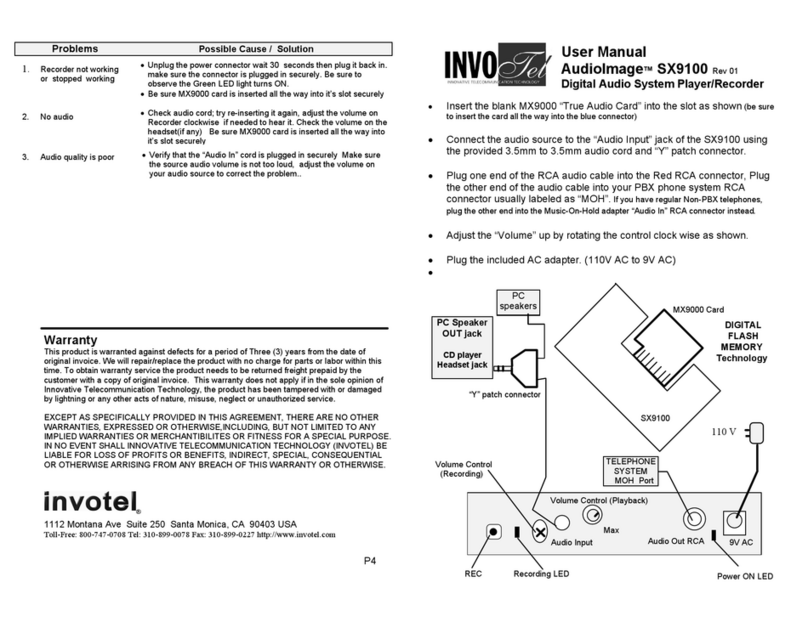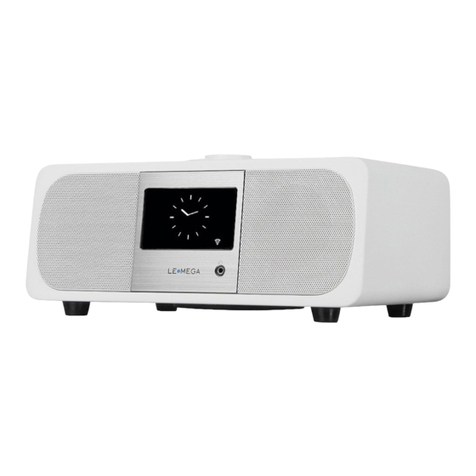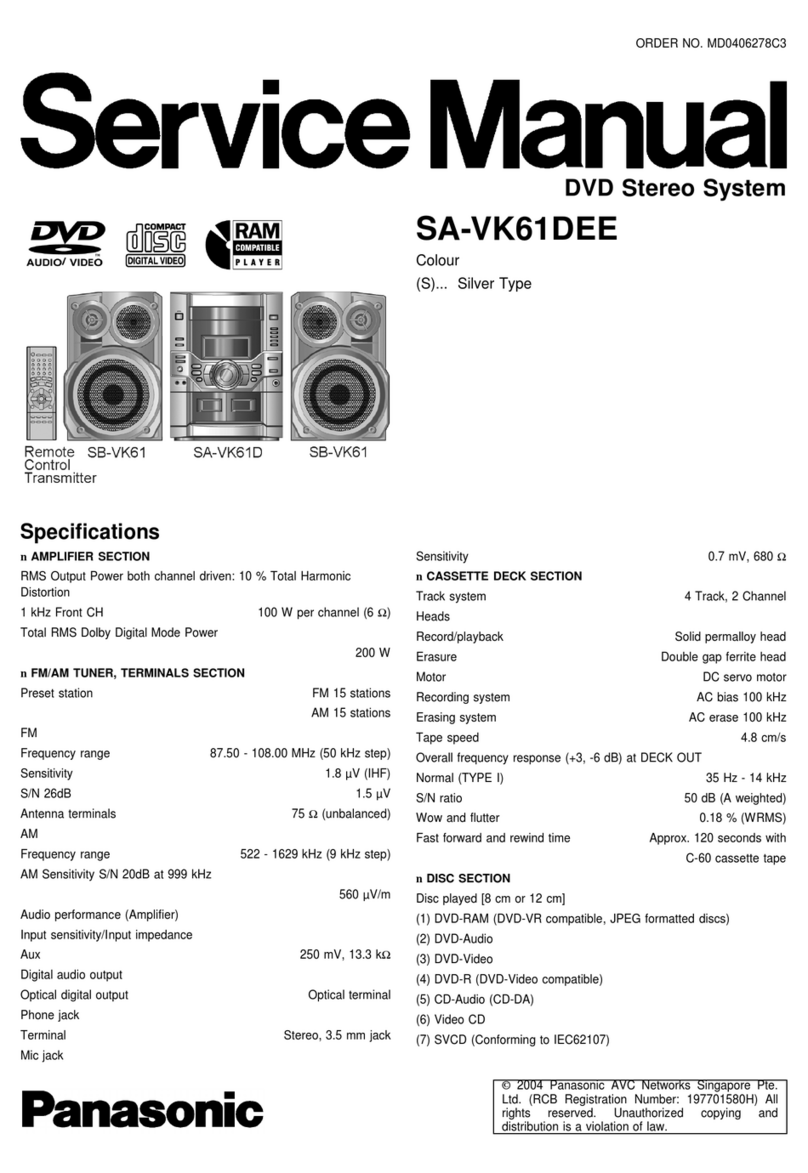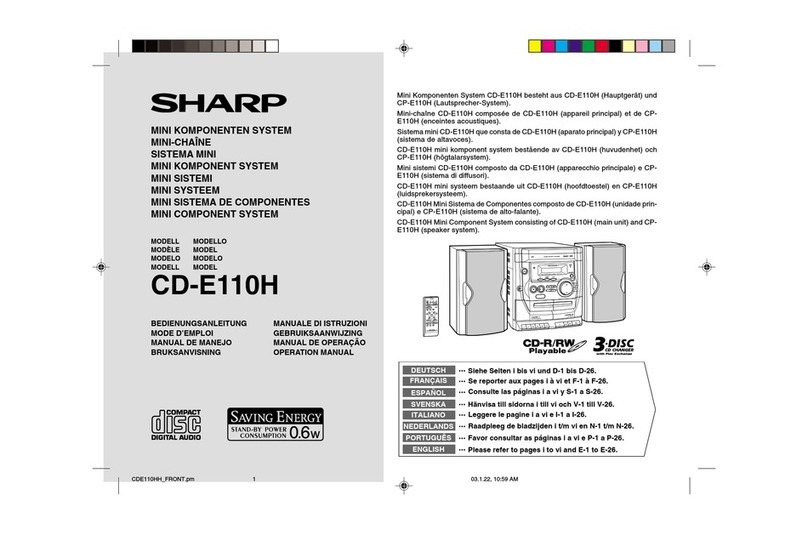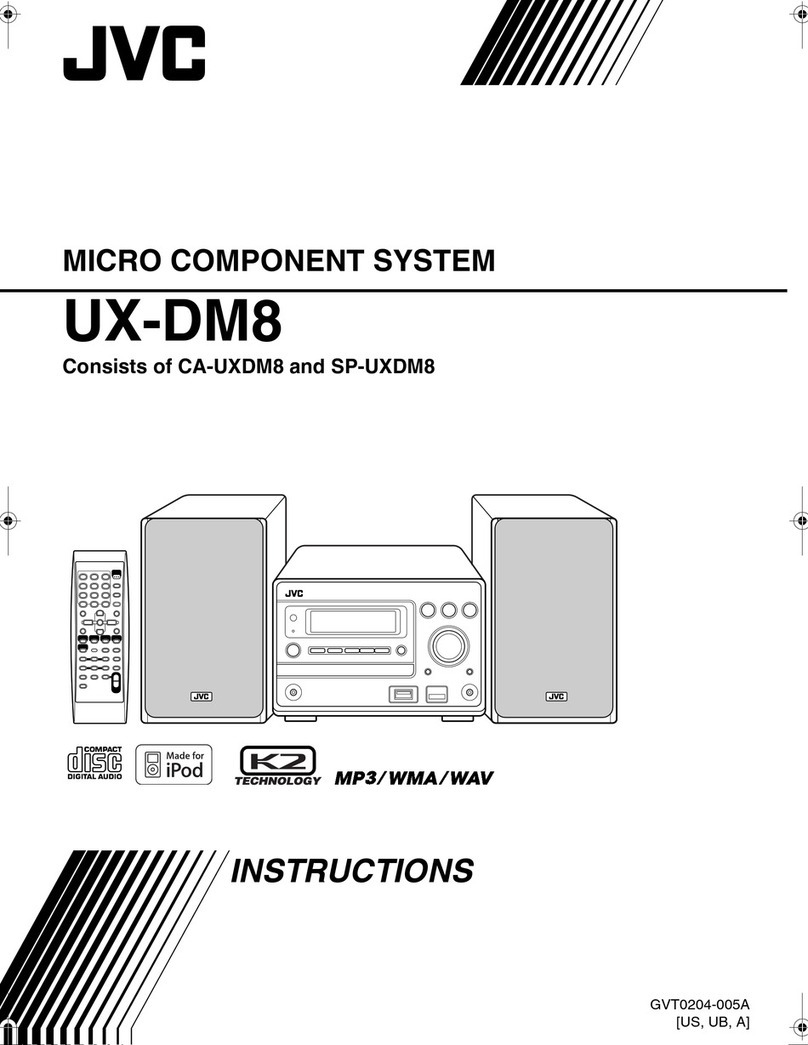LG OM5541 User manual

Mini Hi-Fi System
SERVICE MANUAL
MODEL: OM5541
CAUTION
BEFORE SERVICING THE UNIT, READ THE “SAFETY PRECAUTIONS”
IN THIS MANUAL.
MODEL: OM5541SERVICE MANUAL
P/NO : AFN76793367 SEPTEMBER, 2014
Website http://biz.lgservice.com
Internal Use Only

CONTENTS
SECTION 1 ........ GENERAL
SECTION 2 ........ CABINET & MAIN CHASSIS
SECTION 3 ........ ELECTRICAL
SECTION 4 ........ REPLACEMENT PARTS LIST
1-1

SECTION 1
SUMMARY
CONTENTS
ESD PRECAUTIONS.................................................................................................................................. 1-3
HIDDEN KEY MODE................................................................................................................................... 1-4
SERVICE INFORMATION FOR EEPROM .......................................................................................... 1-5
PROGRAM DOWNLOAD & UPDATE GUIDE ................................................................................... 1-6
1. MICOM PROGRAM .................................................................................................................................. 1-6
2. MCS PROGRAM....................................................................................................................................... 1-7
3. EQ PROGRAM ......................................................................................................................................... 1-8
SPECIFICATIONS ....................................................................................................................................... 1-9
1-2

Electrostatically Sensitive Devices (ESD)
Some semiconductor (solid state) devices can be damaged easily by static electricity. Such components
commonly are called Electrostatically Sensitive Devices (ESD). Examples of typical ESD devices are integrated
circuits and some field-effect transistors and semiconductor chip components. The following techniques should
be used to help reduce the incidence of component damage caused by static electricity.
1. Immediately before handling any semiconductor component or semiconductor-equipped assembly, drain off
any electrostatic charge on your body by touching a known earth ground. Alternatively, obtain and wear a
commercially available discharging wrist strap device, which should be removed for potential shock reasons
prior to applying power to the unit under test.
2. After removing an electrical assembly equipped with ESD devices, place the assembly on a conductive surface
such as aluminum foil, to prevent electrostatic charge buildup or exposure of the assembly.
3. Use only a grounded-tip soldering iron to solder or unsolder ESD devices.
4. Use only an anti-static solder removal device. Some solder removal devices not classified as "anti-static" can
generate electrical charges sufficient to damage ESD devices.
5. Do not use freon-propelled chemicals. These can generate electrical charges sufficient to damage ESD
devices.
6. Do not remove a replacement ESD device from its protective package until immediately before you are
ready to install it. (Most replacement ESD devices are packaged with leads electrically shorted together by
conductive foam, aluminum foil or comparable conductive materials).
7. Immediately before removing the protective material from the leads of a replacement ESD device, touch the
protective material to the chassis or circuit assembly into which the device will by installed.
CAUTION : BE SURE NO POWER IS APPLIED TO THE CHASSIS OR CIRCUIT, AND OBSERVE ALL OTHER
SAFETY PRECAUTIONS.
8. Minimize bodily motions when handing unpackaged replacement ESD devices. (Otherwise harmless motion
such as the brushing together of your clothes fabric or the lifting of your foot from a carpeted floor can generate
static electricity sufficient to damage an ESD device).
CAUTION. GRAPHIC SYMBOLS
THE LIGHTNING FLASH WITH APROWHEAD SYMBOL. WITHIN AN EQUILATERAL TRIANGLE, IS
INTENDED TO ALERT THE SERVICE PERSONNEL TO THE PRESENCE OF UNINSULATED
“DANGEROUS VOLTAGE” THAT MAY BE OF SUFFICIENT MAGNITUDE TO CONSTITUTE A RISK OF
ELECTRIC SHOCK.
THE EXCLAMATION POINT WITHIN AN EQUILATERAL TRIANGLE IS INTENDED TO ALERT THE
SERVICE PERSONNEL TO THE PRESENCE OF IMPORTANT SAFETY INFORMATION IN SERVICE
LITERATURE.
1-3
ESD PRECAUTIONS

1-4
Push both Front key and RCU key to activate it for 5 seconds.
1. Disc Lock On/Off (CD Function Only Active)
Front Key : STOP
RCU Key : STOP
2. Check Version and Option code
Front Key : STOP
RCU Key : PLAY/PAUSE
You can change [Audio MCU Version <-> CD Controller Version <-> EEPROM Option] by SKIP+/-.
3. Clear EEPROM
Front Key : STOP
RCU Key : SKIP-
4. Edit EEPROM
Front Key : STOP
RCU Key : SKIP+
You can change the digit of option by SKIP+/-.
You can edit 0~f by REPEAT or PLAY/PAUSE key.
5. Bluetooth DUT
Front Key : STOP
RCU Key : PROGRAM
Bluetooth model only
6. Power Disc Lock On/Off (CD Function Only Active)
Front Key : STOP
RCU Key : EQ
7. Amp Clip On/Off
Front Key : STOP
RCU Key : Mute
Amp Clip Mode Change (Amp Clip On --> Amp Clip Off --> Level Down display).
HIDDEN KEY MODE

POWER ON
FLD “BT READY” status
It is possible at any function.
(ex. It is possible at FLD “NO USB” status, too.)
This is an example.
Front “STOP” + Remote control “ ”
push same timing during 5s
FLD “op0-…..”
Move to appropriate position
And make changes
with Rmc “ REPEAT” key.
Press STOP Key
FLD “WRITE OK”
Front ‘STOP’ + Remote control “ ”
push same timing during 5s
FLD “E2P CLR”
Completed
NAME
OPT0
OPT1
OPT2
OPT3
OPT4
OPT5
OPT6
OPT7
OPT8
OPT9
DETECT NEW EEPROM
(OPTION EDIT SCREEN)
HEX
09
00
00
00
00
21
83
45
00
00
1-5
SERVICE INFORMATION FOR EEPROM

1. MICOM PROGRAM
Download program file name must be MICOM_OM5541_YYMMDDX.HEX
If security program (Water Wall) is activated on your PC, you must save the file to the USB storage device and
disable the security software, then download the file to your set. Downloading file proceeds in the same way at
USB1 function and USB2 function.
Caution: When downloading the file, you should neither unplug the USB device, change to the other function,
nor power off the device.
USB device must be unplugged when the downloading process is completed.
ON VFD DISPLAY SCREEN
NO USB
↓← Insert USB device at USB function.
SEARCH
↓
MICOM UP
↓
FINISH
↓
Auto POWER OFF
1-6
PROGRAM DOWNLOAD & UPDATE GUIDE

2. MCS PROGRAM
Download program file name must be HG440_OM5541_YYMMDDX.bin
If security program (Water Wall) is activated on your PC, you must save the file to the USB storage device and
disable the security software, then download the file to your set. Downloading file proceeds in the same way at
USB1 function and USB2 function.
Caution: When downloading the file, you should neither unplug the USB device, change to the other function,
nor power off the device.
USB device must be unplugged when the downloading process is completed.
ON VFD DISPLAY SCREEN
NO USB
↓← Insert USB device at USB function.
SEARCH
↓
FIRMWARE
↓
FINISH
↓
Auto POWER OFF
1-7

3. EQ PROGRAM
Download program file name must be EQ_PRG.BIN
If security program (Water Wall) is activated on your PC, you must save the file to the USB storage device and
disable the security software, then download the file to your set. Downloading file proceeds in the same way at
USB1 function and USB2 function.
Caution: When downloading the file, you should neither unplug the USB device, change to the other function,
nor power off the device.
USB device must be unplugged when the downloading process is completed.
ON VFD DISPLAY SCREEN
NO USB
↓← Insert USB device at USB function.
SEARCH
↓
EQ UP
↓
FINISH
↓
Auto POWER OFF
1-8

SPECIFICATIONS
1-9
• GENERAL
Power requirements Refer to the main label.
Power consumption Refer to the main label.
Dimensions (W x H x D) 395.5 mm x 548 mm x 446 mm
Net Weight (Approx.) 16.5 kg
Operating temperature 5 °C to 35 °C (41 °F to 95 °F)
Operating humidity 5 % to 90 %
Bus Power Supply (USB) 5 V 500 mA
• INPUTS
AUX IN 1.2 Vrms (1 kHz, 0 dB, 600 Ω, RCA jack, L/R)
PORT. IN 0.8 Vrms (3.5 ø jack, L/R)
MIC. IN 25 mV
• TUNER
FM Tuning Range 87.5 to 108.0 MHz or 87.50 to 108.00 MHz
• AMPLIFIER
Total 400 W
Front Mono 400 W (at 1 kHz, 4 Ω)
THD 20 %
Design and specifications are subject to change without notice.

1-10

SECTION 2
CABINET & MAIN CHASSIS
CONTENTS
EXPLODED VIEWS..................................................................................................................................... 2-3
1. CABINET AND MAIN FRAME SECTION (OM5541)................................................................................ 2-3
2. PACKING ACCESSORY SECTION ......................................................................................................... 2-5
2-1

2-2

EXPLODED VIEWS
1. CABINET AND MAIN FRAME SECTION (OM5541)
D
L
LED/RCU2
LED
A50
300
I
A
B
I
L
K
K
G
A
D
C
J
J
HG
E
F
E
H
C
NFC Tag
Bluetooth Module
VFD
MIC
KEY/PTB
KEY/USB
MAIN
SMPS
B
250
250
260
261
264
255
270
262
263
265
A47
A46
251
253
291
513
513
A51
A51
464
464
464
464
464
512
514
512
512
512
512 514
512
464
512
512
A43
A48
A49
A44
A42
254
A53
252
CABLE3
CABLE1
CABLE2
464
464
464
464 464
464
464
464
464
464
NOTES) THE EXCLAMATION POINT WITHIN AN
EQUILATERAL TRIANGLE IS INTENDED
TO ALERT THE SERVICE PERSONNEL
TO THE PRESENCE OF IMPORTANT
SAFETY INFORMATION IN SERVICE
LITERATURE.

825 FM Wire Antenna
900 Remote Control
808 Battery
802 Box
801 Instruction Ass'y
804 Bag
803 Packing
803 Packing
2. PACKING ACCESSORY SECTION

SECTION 3 ELECTRICAL
CONTENTS
ONE POINT REPAIR GUIDE................................................................................................................... 3-2
1. NO POWER............................................................................................................................................ 3-2
2. NO BOOTING WHEN POWER ON THE SET ....................................................................................... 3-4
3. VFD IS NOT DISPLAYED WHEN POWER ON THE SET..................................................................... 3-5
4. NO SOUND ............................................................................................................................................ 3-6
ELECTRICAL TROUBLESHOOTING GUIDE.................................................................................. 3-12
1. POWER (SMPS)................................................................................................................................... 3-12
2. MCS PART CHECK.............................................................................................................................. 3-15
3. IC504(M24C16) CHECK....................................................................................................................... 3-15
4. DOUBLE USB FUNCTION................................................................................................................... 3-16
5. FLD DISPLAY CHECK ......................................................................................................................... 3-17
6. PWM MODULATION CHECK .............................................................................................................. 3-18
7. POWER AMP PART CHECK ............................................................................................................... 3-20
8. TUNER / AUX FUNCTION CHECK...................................................................................................... 3-21
9. MIC FUNCTION CHECK...................................................................................................................... 3-22
WAVEFORMS OF MAJOR CHECK POINT ..................................................................................... 3-23
1. SDRAM................................................................................................................................................. 3-23
2. AUDIO PATH........................................................................................................................................ 3-23
3. USB....................................................................................................................................................... 3-23
WIRING DIAGRAM ................................................................................................................................... 3-25
BLOCK DIAGRAMS................................................................................................................................. 3-27
1. SYSTEM BLOCK DIAGRAM_1............................................................................................................ 3-27
2. SYSTEM BLOCK DIAGRAM_2............................................................................................................ 3-29
3. SMPS BLOCK DIAGRAM_1................................................................................................................. 3-31
4. SMPS BLOCK DIAGRAM_2................................................................................................................. 3-33
CIRCUIT DIAGRAMS...............................................................................................................................3-35
1. SMPS CIRCUIT DIAGRAM .................................................................................................................. 3-35
2. MAIN_DSP CIRCUIT DIAGRAM.......................................................................................................... 3-37
3. MAIN_ADC/PWM CIRCUIT DIAGRAM................................................................................................ 3-39
4. MAIN_AMP CIRCUIT DIAGRAM.......................................................................................................... 3-41
5. FRONT_KEY/USB CIRCUIT DIAGRAM .............................................................................................. 3-43
6. FRONT_VFD CIRCUIT DIAGRAM....................................................................................................... 3-45
7. FRONT_KEY/PTB CIRCUIT DIAGRAM............................................................................................... 3-47
8. FRONT_MIC CIRCUIT DIAGRAM ....................................................................................................... 3-49
9. SPK_LED CIRCUIT DIAGRAM ............................................................................................................ 3-51
10. X_LED/RCU2 CIRCUIT DIAGRAM ...................................................................................................... 3-53
CIRCUIT VOLTAGE CHART................................................................................................................. 3-55
1. ICs......................................................................................................................................................... 3-55
2. CAPACITORS....................................................................................................................................... 3-56
3. CONNECTORS .................................................................................................................................... 3-57
PRINTED CIRCUIT BOARD DIAGRAMS ......................................................................................... 3-59
1. SMPS P.C.BOARD............................................................................................................................... 3-59
2. MAIN P.C.BOARD ................................................................................................................................ 3-61
3. FRONT_KEY/USB P.C.BOARD ........................................................................................................... 3-63
4. FRONT_VFD P.C.BOARD ................................................................................................................... 3-63
5. FRONT_KEY/PTB P.C.BOARD ........................................................................................................... 3-65
6. FRONT_MIC P.C.BOARD .................................................................................................................... 3-65
7. SPK_LED P.C.BOARD......................................................................................................................... 3-67
8. X_LED/RCU2 P.C.BOARD................................................................................................................... 3-67
3-1

3-2
ONE POINT REPAIR GUIDE
1. NO POWER
If the unit doesn’t work by no power problem, repair the set according to the following
guide.
(1) FUSE & BRIDGE DIODE
[ Solution ]
Please check and replace F901, BD901, TH901 or TH903 on SMPS board.
[ How to troubleshoot (Countermeasure) ]
1) Check if the fuse F901 is open or short-circuit.
2) Check if the bridge diode BD901 is short-circuit by over current with a digital multi meter.
3) Check if the NTC thermistor TH901 or TH903 is normal or open.
[ Service hint (Any picture / Remark) ]
< F901 >
If F901 is not short-circuit,
replace it with a same
specifications one.
< TH901 >
If TH901 is open,
replace it with a new one.
< BD901 >
If BD901 is short-circuit,
replace it with a new one.
< SMPS circuit diagram >

3-3
ONE POINT REPAIR GUIDE
(2) D951
[ Solution ]
Please check and replace D951 on SMPS board.
[ How to troubleshoot (Countermeasure) ]
1) Check the anode-cathod voltage of D951 with a digital multi-meter, it is normally 0.2 ~ 0.3 V.
If it doesn’t have any voltage, it’s destroyed. Replace it with a new one.
[ Service hint (Any picture / Remark) ]
< SMPS circuit diagram >

3-4
ONE POINT REPAIR GUIDE
2. NO BOOTING WHEN POWER ON THE SET
The set doesn’t work when press the power button on the front board or the remote
control.
(1) FLASH MEMORY
[ Solution ]
Please check and replace IC503 on MAIN board.
[ How to troubleshoot (Countermeasure) ]
1) Check 5.6 V to CN501 in standby mode.
If there is no 5.6 V, check the SMPS.
2) Check 12 V, F+, F- and PVDD when power on the set.
- If the set doesn’t work regardless of what the KEY1 changes high to low while pressing the power button
.
X500 and X501 work normally but, if you can not power on the set, replace IC501 with a new one on
the MAIN board.
[ Service hint (Any picture / Remark) ]
PWR_CTRL(R53D)
KEY1(R542)
< Main Board Top view >

3-5
ONE POINT REPAIR GUIDE
3. VFD IS NOT DISPLAYED WHEN POWER ON THE SET
When power on the set, any icons or characters on VFD are not displayed.
(1) VFD
[ Solution ]
Please check and replace DIG400 on FRONT board.
[ How to troubleshoot (Countermeasure) ]
1) Check if VKK, FL+ and FL- are output from SMPS to VFD via the MAIN board.
2) Check if IC501 outputs VFD_D0, VFD_CLK and VFD_STB to the FRONT board.
3) Check the GR signal(pulse signal) of IC301 on the FRONT board.
Check the SG signal(pulse signal) of IC301 on the FRONT board.
If the GR and SG signal isn’t output, replace IC301 with a new one.
If the GR and SG signal is output, replace DIG302 with a new one.
[ Service hint (Any picture / Remark) ]
GR signal
SG signal
< Waveform of GR and SG signal >
GR SIGNAL
ABOUT 30V
SG SIGNAL
ABOUT 30V
Click the picture,
and then drag to enlarge it.
Check the waveform on details.
Other manuals for OM5541
1
This manual suits for next models
1
Table of contents
Other LG Stereo System manuals




